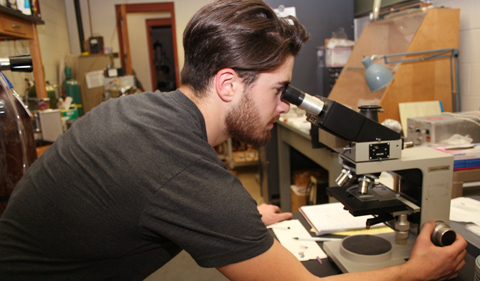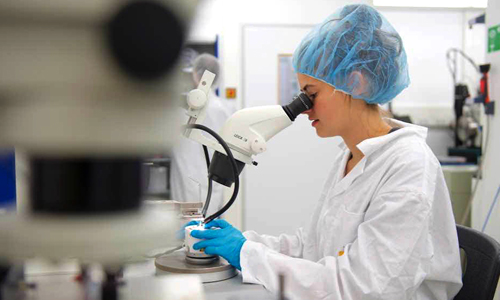
Ari Blumer
By Ari Blumer
(B.S. Engineering Physics, Class of 2018)
I worked during May, June, and July 2015 in Dr. Martin Kordesch’s lab in Physics & Astronomy. My research focused on the growth of two-dimensional transitional metal dichalcogenides (TMDs); specifically tungsten disulfide (WS2) and molybdenum disulfide (MoS2). TMDs are compounds that consist of a transition metal, (the chemicals that are located in the middle of the periodic table), and 2 sulphur or selenium atoms. (T=transition metal, Di = 2, chalcogenide= S or Se). For our transitional metal, we used tungsten (W), and Molybdenum (Mo).
In the beginning of my internship, I had to do quite a lot of reading to understand how monolayer crystals behave and why. Once I had a sufficient understanding, I began growing the crystals through a process called ‘chemical vapor deposition’ in a tube furnace.
Because the growing happens at an extremely high temperature (around 900°C), I was limited to the number of samples I could grow per day, as the cool-down process took a while. During the first two months, I went through many samples, attempting to find out what makes the crystals grow better and what inhibits them.
The goal was to get crystals that were large in surface area, but remain atomically thin, hence “2-dimensional.” Growing these crystals is important because, they share similar properties to graphene, yet they are semiconductors, which makes them much more powerful for nano-electronics. For this reason, TMDs have been a common research focus globally.
Throughout July, I worked with Dr. Kordesch to build our own microscope heating stage, in order to observe the crystals at high temperature, and eventually watch them grow.
Through much trial and error, we managed to heat a small sample with crystals to a temperature of about 900°C, while still being able to see the crystals using the microscope. The next step is to further study the growing process to understand more about it; then test the electronic properties.
My summer research experience with Dr. Kordesch was invaluable. I feel very fortunate to have been able to work with him so closely and to be able to learn so much.
Ari Blumer – 2015 Intern with Dr. Martin Kordesch – sophomore at Ohio University – Honors Tutorial College – engineering physics major



















Comments